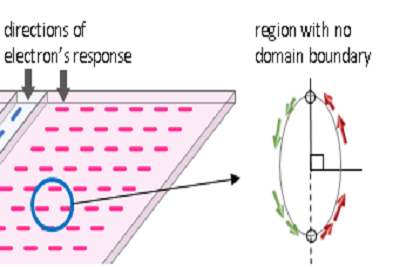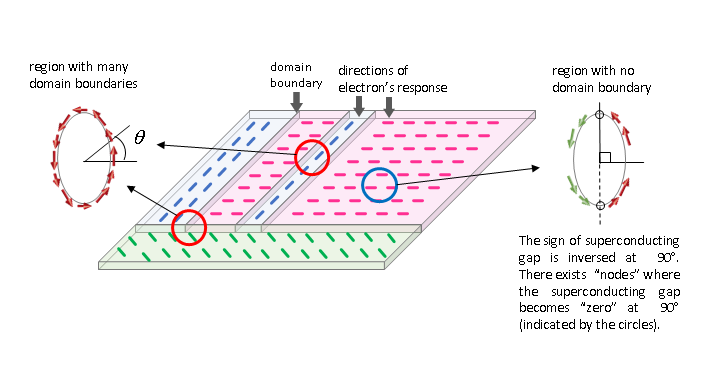Discovery of important phenomenon for understanding mechanism of superconductivity The discovery of disappearing superconducting gap 'nodes'


On the surface of iron selenide (FeSe), some regions have many domain boundaries of electronic nematic ordering while others have few boundaries. Around the region with many domain boundaries, due to the breaking of time reversal symmetry, the superconducting gap nodes, which should exist without the domains, seem to disappear.
© 2018 Madoka Mochida and Kozo Okazaki.
Researchers at the University of Tokyo and their collaborators have directly observed the superconducting gap of iron selenide, which was revealed as it showed an ordered state called the electronic nematic order.
The research group comprised Project Associate Professor Kozo Okazaki, Professor Shik Shin and graduate student Takahiro Hashimoto at the Institute for Solid State Physics, collaborating with Professor Takasada Shibauchi at the Graduate School of Frontier Sciences at the University of Tokyo and Professor Yuji Matsuda at the Graduate School of Science at Kyoto University.
Using an ultralow-temperature and high-energy resolution laser ARPES apparatus, the researchers found that the anisotropy of the superconducting gap, which is quite an important character to understand the mechanism of superconductivity, is sensitively affected by the domain structures of so-called electronic nematic ordering. Whereas the superconducting gap nodes exist around the region with few domain boundaries, they disappear around the region with many domain boundaries.
These research achievements demonstrate that the ultralow-temperature and high-energy resolution laser ARPES apparatus is quite useful to confirm whether nodes exist in the superconducting gap.
This study will aid our understanding of the superconduction mechanism to reveal the superconducting gap structures of various superconductors. The research holds promise of leading to the realization of superconductivity at higher temperatures and, moreover, superconductivity at room temperature.
"At first, we were very surprised and couldn't believe our experimental results that superconducting gap nodes disappear by the domain structure of electronic nematic ordering," says Okazaki. He continues, "However, since we succeeded in reproducing the results, we have confidence in our findings and believe that they will be very important for the study of superconductivity in the future."
Papers
Takahiro Hashimoto, Yuichi Ota, Haruyoshi Q. Yamamoto, Yuya Suzuki, Takahiro Shimojima, Shuntaro Watanabe, Chuangtian Chen, Shigeru Kasahara, Yuji Matsuda, Takasada Shibauchi, Kozo Okazaki, and Shik Shin, "Superconducting gap anisotropy sensitive to nematic domains in FeSe," Nature Communications: January 18, 2018, doi:10.1038/s41467-017-02739-y.
Link (Publication )
)





